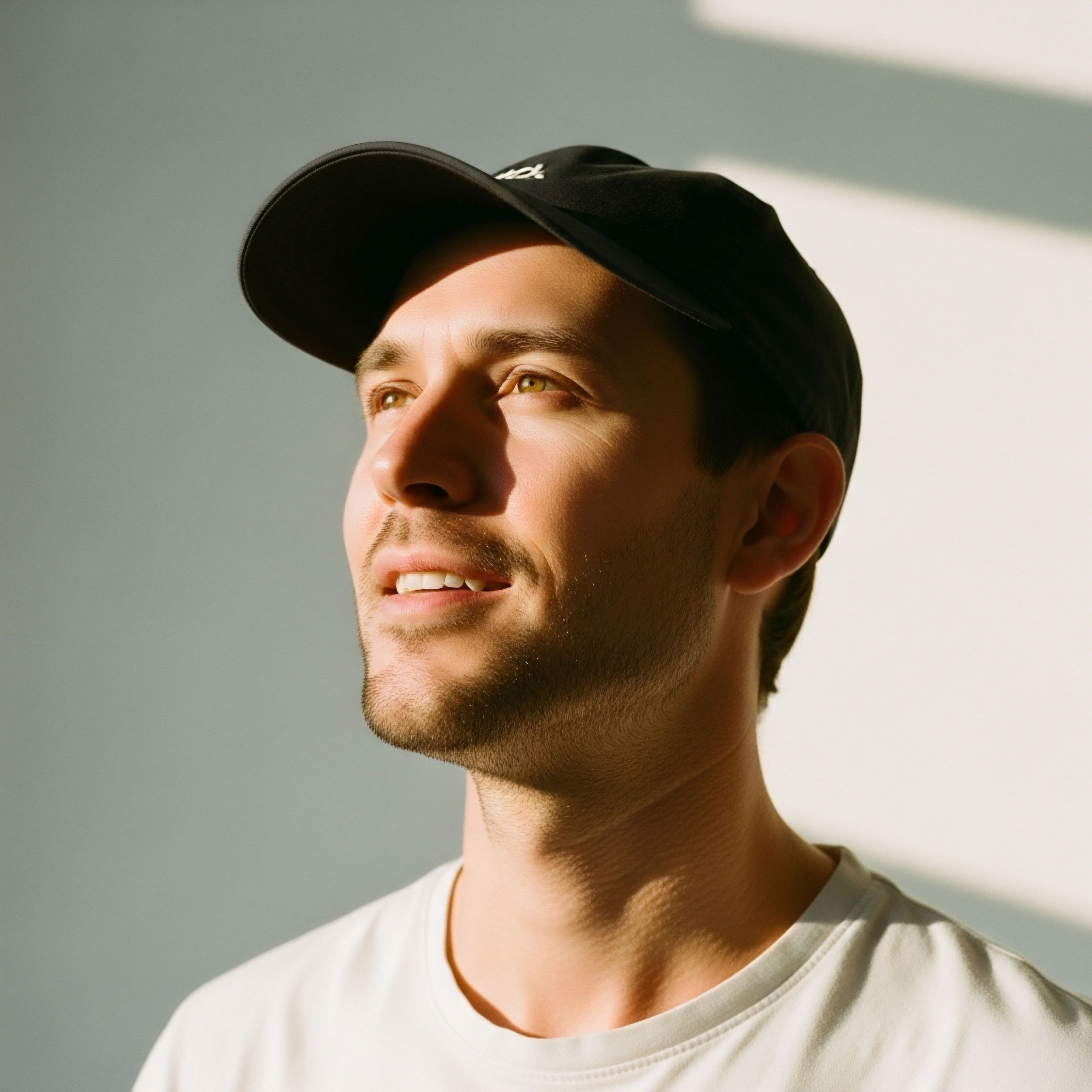

Fundamentals
The journey toward restoring fertility often begins with a quiet, internal sense that a fundamental system is offline. It is a deeply personal awareness that your body’s vitality and generative capacity are not functioning as they should. This experience is valid, and understanding its biological origins is the first step toward reclaiming control.
The body’s reproductive capabilities are governed by an intricate and constant stream of communication between the brain and the gonads. When this dialogue falters, the entire system can stall. The solution lies in understanding the language the body uses and finding a way to restart that conversation with precision.
At the center of this biological governance is the Hypothalamic-Pituitary-Gonadal (HPG) axis. This network acts as the primary regulatory system for human reproduction and endocrine health. The hypothalamus, a small region at the base of the brain, releases a specific signaling molecule called Gonadotropin-Releasing Hormone (GnRH) in a rhythmic, pulsatile manner.
Each pulse is a command, a message sent to the nearby pituitary gland. The pituitary, in turn, responds by releasing two other critical hormones into the bloodstream ∞ Luteinizing Hormone (LH) and Follicle-Stimulating Hormone (FSH). These hormones travel to the gonads (the testes in men) and deliver the final instructions for testosterone production and spermatogenesis, the process of sperm creation. This entire sequence is a delicate, cascading signal that maintains reproductive function.
Gonadorelin therapy functions by precisely mimicking the body’s natural, rhythmic hormonal signals to reactivate the reproductive system.

The Body’s Internal Dialogue for Fertility
A disruption anywhere along the HPG axis can silence this vital communication. If the hypothalamus fails to send its GnRH signal correctly, the pituitary never receives its instructions, and the testes remain dormant. This condition, known as hypogonadotropic hypogonadism, is a common cause of infertility.
It is a functional issue rooted in signaling, a silent command center. The challenge, therefore, is one of communication breakdown. The physical machinery for producing testosterone and sperm may be perfectly intact, yet it remains inactive without the proper commands from the brain. Restoring fertility in this context requires a solution that can replicate the missing signal with biological accuracy.
This is where the unique role of Gonadorelin becomes clear. Gonadorelin is a synthetic version of the natural GnRH molecule. Its structure is identical to the hormone your own hypothalamus produces. Administering it provides the precise, initial command that the system is missing.
It speaks the body’s native hormonal language, delivering the exact message the pituitary gland is designed to receive. This targeted action allows the entire downstream cascade to resume its natural function. The pituitary releases LH and FSH, and the testes respond by initiating testosterone synthesis and sperm production, effectively restarting the entire reproductive engine.

Gonadorelin a Precise Messenger
The therapeutic power of Gonadorelin lies in its ability to restore a natural process. It acts as a master key, unlocking the potential that already exists within the body’s endocrine architecture. The therapy is designed around the body’s own operational logic.
By reintroducing the initial GnRH pulse, it prompts the pituitary to function as it is meant to, which in turn activates the testes. This approach respects the complexity of the HPG axis, using a single, targeted input to reboot a multi-stage system. The goal is to re-establish the body’s own rhythmic production of the hormones necessary for fertility.

Restoring the Natural Pulse
The effectiveness of this biochemical recalibration hinges on mimicking the natural rhythm of GnRH release. The hypothalamus does not release a steady stream of GnRH; it releases it in discrete bursts, or pulses, throughout the day. This pulsatility is essential for maintaining the sensitivity of the receptors in the pituitary gland.
Gonadorelin therapy is administered in a way that replicates this natural cadence, typically through a small pump that delivers the hormone in programmed pulses. This method ensures the pituitary receives the signal in the way it expects, leading to a sustained and balanced release of LH and FSH.
This biomimetic approach is fundamental to the long-term success of the therapy, as it encourages the body to resume its own finely tuned hormonal dance, paving the way for restored testicular function and fertility.


Intermediate
Understanding the foundational role of Gonadorelin as a biological signal allows for a deeper appreciation of its clinical application. The long-term objective of the therapy is the restoration of the body’s innate capacity for spermatogenesis and androgen production.
This is achieved through carefully designed protocols that honor the physiological principles of the HPG axis, specifically the necessity of pulsatile stimulation. The administration of Gonadorelin is calibrated to reproduce the natural frequency and amplitude of hypothalamic GnRH secretion, which is the key to reactivating and maintaining pituitary and gonadal function over time. This method ensures the therapy works in concert with the body’s established biological systems.

The Clinical Application of Pulsatile Therapy
In a clinical setting, Gonadorelin is most often delivered via a portable infusion pump. This device is programmed to administer a subcutaneous dose of the hormone at regular intervals, typically every 90 to 120 minutes. This method is designed to replicate the natural, rhythmic bursts of GnRH from the hypothalamus.
By doing so, it maintains the sensitivity of the pituitary gonadotroph cells, which are responsible for producing LH and FSH. A continuous, non-pulsatile infusion would lead to receptor downregulation and a shutdown of the pituitary’s response, so this rhythmic delivery is a central component of successful treatment. The restoration of fertility is a direct consequence of this re-established signaling cascade.
The typical progression of treatment follows a predictable physiological sequence:
- Initial Phase (First 1-3 months) ∞ The primary response is the normalization of LH and FSH secretion from the pituitary gland. This leads to a rise in serum testosterone levels, which addresses the symptoms of hypogonadism, such as low energy and libido. Testicular volume begins to increase as the Leydig and Sertoli cells within the testes are reactivated.
- Spermatogenesis Phase (3-12 months) ∞ Following the initial hormonal response, the testes begin the complex process of spermatogenesis. FSH stimulates the Sertoli cells, which are the “nursery” for developing sperm, while LH stimulates the Leydig cells to produce the testosterone necessary for sperm maturation. The appearance of sperm in the ejaculate can take several months, as the full cycle of sperm production is approximately 74 days.
- Maintenance Phase (Ongoing) ∞ Once spermatogenesis is established, the therapy is continued to maintain the necessary hormonal signaling. The long-term outcome is the sustained production of sperm, allowing for natural conception. The protocol is designed to maintain testicular function and volume for as long as fertility is desired.
Effective Gonadorelin therapy hinges on mimicking the natural pulsatile release of GnRH, which is essential for sustained pituitary response.

Gonadorelin versus Human Chorionic Gonadotropin
Before Gonadorelin became a primary therapy, human chorionic gonadotropin (HCG) was commonly used to stimulate the testes. While both can be effective, they operate at different points in the HPG axis, and this distinction is important for understanding long-term outcomes.
HCG works by directly stimulating the LH receptors on the Leydig cells in the testes, bypassing the hypothalamus and pituitary altogether. Gonadorelin, conversely, stimulates the entire axis from the top down. The table below outlines the key differences in their mechanisms and clinical implications.
| Feature | Gonadorelin Therapy | Human Chorionic Gonadotropin (HCG) Therapy |
|---|---|---|
| Mechanism of Action | Acts on the pituitary gland to stimulate the release of both LH and FSH. | Directly mimics LH, stimulating only the testes. It does not stimulate FSH release. |
| Physiological Effect | Restores the entire HPG axis function, promoting a balanced, natural release of both gonadotropins. | Bypasses the brain’s role, leading primarily to testosterone production with less direct stimulation of spermatogenesis via the FSH pathway. |
| Hormonal Response | Induces production of both LH and FSH, which supports both testosterone synthesis and Sertoli cell function for spermatogenesis. | Primarily stimulates testosterone production. FSH levels may remain suppressed, sometimes requiring co-administration of FSH for full fertility restoration. |
| Clinical Application | Ideal for cases of hypothalamic dysfunction (hypogonadotropic hypogonadism) where the pituitary and testes are healthy. | Often used to stimulate testosterone production during TRT or when a direct testicular stimulus is needed. |

What Are the Practical Expectations during Treatment?
A patient undergoing Gonadorelin therapy for fertility restoration embarks on a process of systematic biological recalibration. The initial weeks are focused on titrating the dose to achieve a normal physiological response from the pituitary. Blood tests are used to monitor LH, FSH, and testosterone levels to ensure the signaling cascade has been successfully initiated.
As treatment progresses, the focus shifts to monitoring testicular volume and, eventually, semen analysis to confirm the onset of spermatogenesis. The long-term success of the therapy is defined by the achievement of these physiological milestones, which collectively represent the restoration of the body’s natural reproductive function. This process requires patience, as it involves reactivating a biological system that may have been dormant for years.

Monitoring and Adjustment Protocols
Throughout the treatment, regular clinical monitoring is essential. This involves a combination of laboratory testing and physical examination to ensure the protocol is achieving its intended effects without adverse reactions. Adjustments to the pump’s pulse dosage may be made based on the hormonal response.
The goal is always to use the lowest effective dose to mimic a natural physiological state. This careful, data-driven management is key to the safety and efficacy of the therapy, ensuring that the restored fertility is a stable, long-term outcome. The sustained health of the HPG axis is the ultimate objective.


Academic
An academic exploration of Gonadorelin therapy’s long-term outcomes requires a shift in perspective from clinical application to the underlying physiological and molecular mechanisms. The sustained success of this treatment modality in restoring fertility, particularly in men with idiopathic hypogonadotropic hypogonadism (IHH), is predicated on its ability to re-establish the normative pulsatile signaling of the HPG axis.
The durability of its effects, both during and after treatment, depends on a complex interplay of factors including baseline patient characteristics, pituitary responsiveness, and the integrity of gonadal tissue. A thorough analysis moves beyond the simple confirmation of spermatogenesis to an investigation of the predictors of success and the cellular adaptations that govern the therapy’s lasting impact.

Predicting Long Term Success in Gonadorelin Protocols
Clinical research has identified several key predictors that correlate with favorable long-term outcomes in men undergoing pulsatile GnRH therapy. These variables provide insight into the patient’s underlying physiological capacity to respond to the reintroduction of the primary hypothalamic signal.
A landmark study published in the Journal of Clinical Endocrinology & Metabolism examined 76 men with IHH and identified critical baseline factors for achieving normal testicular volume and spermatogenesis. These predictors help stratify patients and manage expectations regarding the timeline and potential ceiling of therapeutic success.
The following table summarizes the primary predictors of a successful outcome, drawing from established clinical evidence. A patient’s history and baseline endocrine profile are highly informative of their potential response trajectory.
| Predictor Variable | Favorable Indicator | Clinical Significance |
|---|---|---|
| Prior Pubertal Development | Evidence of partial or complete puberty (Group 2 or 3 in studies). | Indicates that the HPG axis was previously functional, suggesting the system is more amenable to being reactivated. Patients with no prior development (Group 1) have a longer path to success. |
| Baseline Testicular Volume | A larger initial testicular volume (e.g. > 4 mL). | A larger starting volume suggests a greater number of Sertoli and Leydig cells are present and available for stimulation, providing a better foundation for growth and function. |
| History of Cryptorchidism | Absence of a history of undescended testes. | Cryptorchidism can be associated with intrinsic testicular damage, which may limit the gonads’ ability to respond to hormonal stimulation, regardless of how well the HPG axis is activated. |
| Baseline Inhibin B Levels | Higher levels of Inhibin B (e.g. > 60 pg/ml). | Inhibin B is a hormone produced by Sertoli cells. A higher baseline level is a direct marker of Sertoli cell health and number, which is a strong predictor of future spermatogenesis capacity. |

Cellular Mechanisms and Pituitary Adaptation
The long-term efficacy of Gonadorelin therapy is rooted in its interaction with GnRH receptors on the pituitary gonadotrophs. The pulsatile nature of the administration is paramount. It prevents the homologous desensitization and downregulation of these receptors, a phenomenon that occurs with continuous GnRH agonist exposure.
Each pulse of Gonadorelin triggers a cascade of intracellular signaling involving G-protein-coupled receptors, leading to the synthesis and release of LH and FSH. Over time, this rhythmic stimulation can lead to an increase in the number and sensitivity of GnRH receptors, effectively “re-educating” the pituitary gland and enhancing its responsiveness.
This cellular adaptation is a key component of the therapy’s durable effect. The differential synthesis of LH and FSH is also a topic of academic interest, as the frequency of GnRH pulses can selectively favor the release of one gonadotropin over the other, allowing for fine-tuning of the therapeutic response.
Long-term success with Gonadorelin is strongly predicted by baseline testicular volume and evidence of prior pubertal development.

How Does Gonadorelin Influence the HPG Axis Long Term?
A central question in the academic assessment of Gonadorelin therapy is its potential to induce permanent or sustained changes in the HPG axis after treatment cessation. For most cases of IHH, the underlying hypothalamic defect is permanent, and therefore, continuous therapy is required to maintain fertility.
The treatment is a functional replacement for a missing signal. However, in a subset of patients, particularly those with delayed puberty or partial IHH, long-term pulsatile GnRH therapy may induce a durable activation of the endogenous GnRH pulse generator.
The mechanism for this is not fully understood but may involve the maturation of neural pathways under the influence of normalized sex steroid levels. In these specific cases, the therapy acts as an initiator of puberty, after which the patient’s own HPG axis can maintain function independently.

Sustained off Treatment Efficacy a Review of Evidence
Evidence for sustained off-treatment efficacy is limited but present in specific patient populations. Studies have documented cases where patients, after a course of Gonadorelin therapy, maintained normal testosterone levels and even sperm production long after the pump was discontinued. These cases are typically associated with patients who had some degree of spontaneous pubertal development to begin with.
This suggests that the therapy served as a catalyst for completing a developmental process. For the majority of men with congenital IHH, the long-term outcome is one of successful, sustained fertility for the duration of the therapy. The treatment is viewed as a highly effective and physiologic replacement therapy, restoring the body’s systems to a state of normal function rather than curing the underlying hypothalamic deficiency.

References
- Crowley, W. F. & Whitcomb, R. W. (1990). The use of gonadotropin-releasing hormone in the induction of puberty. The New England Journal of Medicine, 322(22), 1610-1616.
- Belisle, S. & Tulchinsky, D. (1980). Integrated hormonal patterns in female infertility. The Journal of Clinical Endocrinology & Metabolism, 51(4), 665-671.
- Liu, L. & Banks, S. M. (1988). The duration of gonadotropin-releasing hormone (GnRH) action in men with GnRH deficiency ∞ a comparison of the effects of daily subcutaneous injections and continuous subcutaneous infusion of GnRH. The Journal of Clinical Endocrinology & Metabolism, 67(3), 608-613.
- Pitteloud, N. Hayes, F. J. Boepple, P. A. DeCruz, S. Seminara, S. B. MacLaughlin, D. T. & Crowley, W. F. (2002). Predictors of outcome of long-term GnRH therapy in men with idiopathic hypogonadotropic hypogonadism. The Journal of Clinical Endocrinology & Metabolism, 87(9), 4128-4136.
- Hoffman, A. R. & Crowley, W. F. (1982). Induction of puberty in men by long-term pulsatile administration of low-dose gonadotropin-releasing hormone. The New England Journal of Medicine, 307(20), 1237-1241.
- Mortensen, E. & Tenga, A. (2020). Gonadorelin for veterinary use. Journal of Veterinary Pharmacology and Therapeutics, 43(1), 1-10.
- Spratt, D. I. Finkelstein, J. S. O’Dea, L. S. Badger, T. M. & Crowley, W. F. (1986). Long-term administration of gonadotropin-releasing hormone in men with idiopathic hypogonadotropic hypogonadism. Annals of Internal Medicine, 105(6), 848-855.

Reflection
The information presented here provides a map of a specific biological territory. It details the signals, the pathways, and the clinical strategies involved in restoring a fundamental human function. This knowledge is a powerful tool. It transforms a vague sense of dysfunction into a well-defined physiological challenge with a logical, evidence-based solution.
The process of fertility restoration is a journey back to an innate biological rhythm. It is about understanding the intricate communication that governs your body and using precise tools to help it speak its native language again.

Your Biological Blueprint
Your health is a dynamic, interconnected system. The principles that govern the HPG axis ∞ of signaling, feedback, and rhythm ∞ are echoed throughout your entire physiology. Consider how this understanding of one system might inform your perspective on your overall well-being.
The path forward involves a partnership with your own biology, guided by a clear comprehension of its operating principles. The ultimate goal is to move from a state of questioning your body to a place of understanding it, enabling you to take proactive and informed steps toward your personal health objectives.



